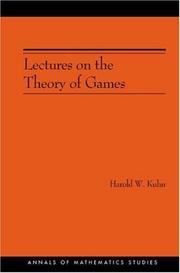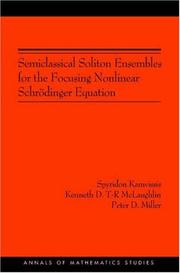| Listing 1 - 2 of 2 |
Sort by
|

ISBN: 0691027714 0691027722 9786612159114 1282159119 1400829569 9781400829569 9781282159112 6612159111 9780691027715 9780691027722 Year: 2003 Volume: 37 Publisher: Princeton, N.J. : Princeton University Press,
Abstract | Keywords | Export | Availability | Bookmark
 Loading...
Loading...Choose an application
- Reference Manager
- EndNote
- RefWorks (Direct export to RefWorks)
This book is a spectacular introduction to the modern mathematical discipline known as the Theory of Games. Harold Kuhn first presented these lectures at Princeton University in 1952. They succinctly convey the essence of the theory, in part through the prism of the most exciting developments at its frontiers half a century ago. Kuhn devotes considerable space to topics that, while not strictly the subject matter of game theory, are firmly bound to it. These are taken mainly from the geometry of convex sets and the theory of probability distributions. The book opens by addressing "matrix games," a name first introduced in these lectures as an abbreviation for two-person, zero-sum games in normal form with a finite number of pure strategies. It continues with a treatment of games in extensive form, using a model introduced by the author in 1950 that quickly supplanted von Neumann and Morgenstern's cumbersome approach. A final section deals with games that have an infinite number of pure strategies for the two players. Throughout, the theory is generously illustrated with examples, and exercises test the reader's understanding. A historical note caps off each chapter. For readers familiar with the calculus and with elementary matrix theory or vector analysis, this book offers an indispensable store of vital insights on a subject whose importance has only grown with the years.
Operational research. Game theory --- Game theory --- 519.83 --- Theory of games --- 519.83 Theory of games --- Game theory. --- Games, Theory of --- Mathematical models --- Mathematics --- Abstract algebra. --- Addition. --- Algorithm. --- Almost surely. --- Analytic geometry. --- Axiom. --- Basic solution (linear programming). --- Big O notation. --- Bijection. --- Binary relation. --- Boundary (topology). --- Bounded set (topological vector space). --- Branch point. --- Calculation. --- Cardinality of the continuum. --- Cardinality. --- Cartesian coordinate system. --- Characteristic function (probability theory). --- Combination. --- Computation. --- Connectivity (graph theory). --- Constructive proof. --- Convex combination. --- Convex function. --- Convex hull. --- Convex set. --- Coordinate system. --- David Gale. --- Diagram (category theory). --- Differential equation. --- Dimension (vector space). --- Dimensional analysis. --- Disjoint sets. --- Distribution function. --- Embedding. --- Empty set. --- Enumeration. --- Equation. --- Equilibrium point. --- Equivalence relation. --- Estimation. --- Euclidean space. --- Existential quantification. --- Expected loss. --- Extreme point. --- Formal scheme. --- Fundamental theorem. --- Galois theory. --- Geometry. --- Hyperplane. --- Inequality (mathematics). --- Infimum and supremum. --- Integer. --- Iterative method. --- Line segment. --- Linear equation. --- Linear inequality. --- Matching Pennies. --- Mathematical induction. --- Mathematical optimization. --- Mathematical theory. --- Mathematician. --- Mathematics. --- Matrix (mathematics). --- Measure (mathematics). --- Min-max theorem. --- Minimum distance. --- Mutual exclusivity. --- Prediction. --- Probability distribution. --- Probability interpretations. --- Probability measure. --- Probability theory. --- Probability. --- Proof by contradiction. --- Quantity. --- Rank (linear algebra). --- Rational number. --- Real number. --- Requirement. --- Scientific notation. --- Sign (mathematics). --- Solution set. --- Special case. --- Statistics. --- Strategist. --- Strategy (game theory). --- Subset. --- Theorem. --- Theory of Games and Economic Behavior. --- Theory. --- Three-dimensional space (mathematics). --- Total order. --- Two-dimensional space. --- Union (set theory). --- Unit interval. --- Unit square. --- Vector Analysis. --- Vector calculus. --- Vector space.

ISBN: 1299443451 1400837189 069111482X 0691114838 9781400837182 9781299443457 9780691114835 9780691114828 Year: 2003 Publisher: Princeton, NJ : Princeton University Press,
Abstract | Keywords | Export | Availability | Bookmark
 Loading...
Loading...Choose an application
- Reference Manager
- EndNote
- RefWorks (Direct export to RefWorks)
This book represents the first asymptotic analysis, via completely integrable techniques, of the initial value problem for the focusing nonlinear Schrödinger equation in the semiclassical asymptotic regime. This problem is a key model in nonlinear optical physics and has increasingly important applications in the telecommunications industry. The authors exploit complete integrability to establish pointwise asymptotics for this problem's solution in the semiclassical regime and explicit integration for the underlying nonlinear, elliptic, partial differential equations suspected of governing the semiclassical behavior. In doing so they also aim to explain the observed gradient catastrophe for the underlying nonlinear elliptic partial differential equations, and to set forth a detailed, pointwise asymptotic description of the violent oscillations that emerge following the gradient catastrophe. To achieve this, the authors have extended the reach of two powerful analytical techniques that have arisen through the asymptotic analysis of integrable systems: the Lax-Levermore-Venakides variational approach to singular limits in integrable systems, and Deift and Zhou's nonlinear Steepest-Descent/Stationary Phase method for the analysis of Riemann-Hilbert problems. In particular, they introduce a systematic procedure for handling certain Riemann-Hilbert problems with poles accumulating on curves in the plane. This book, which includes an appendix on the use of the Fredholm theory for Riemann-Hilbert problems in the Hölder class, is intended for researchers and graduate students of applied mathematics and analysis, especially those with an interest in integrable systems, nonlinear waves, or complex analysis.
Schrodinger equation. --- Wave mechanics. --- Equation, Schrödinger --- Schrödinger wave equation --- Electrodynamics --- Matrix mechanics --- Mechanics --- Molecular dynamics --- Quantum statistics --- Quantum theory --- Waves --- Differential equations, Partial --- Particles (Nuclear physics) --- Wave mechanics --- WKB approximation --- Schrödinger equation. --- Schrödinger, Équation de. --- Solitons. --- Abelian integral. --- Analytic continuation. --- Analytic function. --- Ansatz. --- Approximation. --- Asymptote. --- Asymptotic analysis. --- Asymptotic distribution. --- Asymptotic expansion. --- Banach algebra. --- Basis (linear algebra). --- Boundary (topology). --- Boundary value problem. --- Bounded operator. --- Calculation. --- Cauchy's integral formula. --- Cauchy's integral theorem. --- Cauchy's theorem (geometry). --- Cauchy–Riemann equations. --- Change of variables. --- Coefficient. --- Complex plane. --- Cramer's rule. --- Degeneracy (mathematics). --- Derivative. --- Diagram (category theory). --- Differentiable function. --- Differential equation. --- Differential operator. --- Dirac equation. --- Disjoint union. --- Divisor. --- Eigenfunction. --- Eigenvalues and eigenvectors. --- Elliptic integral. --- Energy minimization. --- Equation. --- Euler's formula. --- Euler–Lagrange equation. --- Existential quantification. --- Explicit formulae (L-function). --- Fourier transform. --- Fredholm theory. --- Function (mathematics). --- Gauge theory. --- Heteroclinic orbit. --- Hilbert transform. --- Identity matrix. --- Implicit function theorem. --- Implicit function. --- Infimum and supremum. --- Initial value problem. --- Integrable system. --- Integral curve. --- Integral equation. --- Inverse problem. --- Jacobian matrix and determinant. --- Kerr effect. --- Laurent series. --- Limit point. --- Line (geometry). --- Linear equation. --- Linear space (geometry). --- Logarithmic derivative. --- Lp space. --- Minor (linear algebra). --- Monotonic function. --- Neumann series. --- Normalization property (abstract rewriting). --- Numerical integration. --- Ordinary differential equation. --- Orthogonal polynomials. --- Parameter. --- Parametrix. --- Paraxial approximation. --- Parity (mathematics). --- Partial derivative. --- Partial differential equation. --- Perturbation theory (quantum mechanics). --- Perturbation theory. --- Pole (complex analysis). --- Polynomial. --- Probability measure. --- Quadratic differential. --- Quadratic programming. --- Radon–Nikodym theorem. --- Reflection coefficient. --- Riemann surface. --- Simultaneous equations. --- Sobolev space. --- Soliton. --- Special case. --- Taylor series. --- Theorem. --- Theory. --- Trace (linear algebra). --- Upper half-plane. --- Variational method (quantum mechanics). --- Variational principle. --- WKB approximation. --- Schrödinger, Équation de.
| Listing 1 - 2 of 2 |
Sort by
|

 Search
Search Feedback
Feedback About
About Help
Help News
News